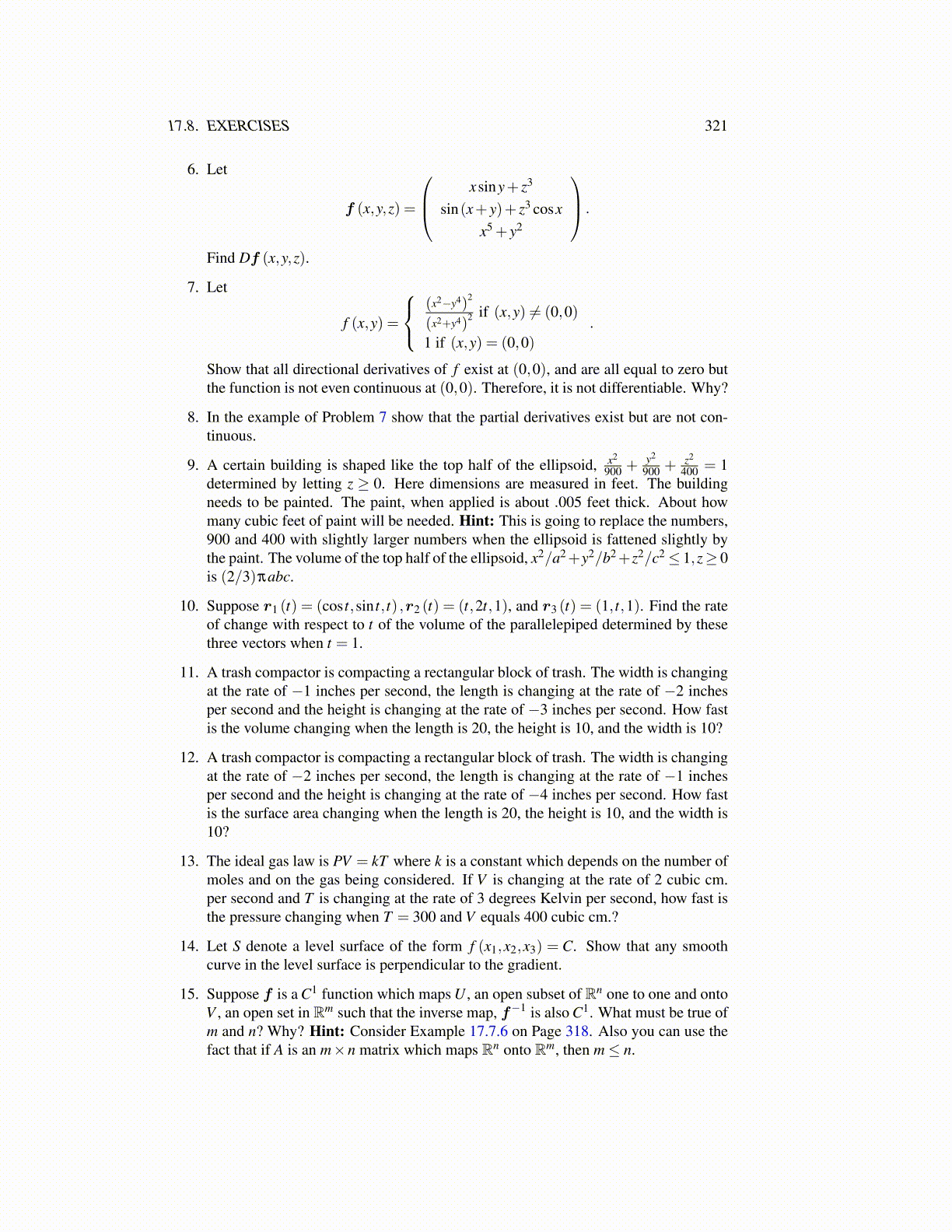
17.8. EXERCISES 321
6. Let
f (x,y,z) =
xsiny+ z3
sin(x+ y)+ z3 cosxx5 + y2
.
Find Df (x,y,z).
7. Let
f (x,y) =
(x2−y4)
2
(x2+y4)2 if (x,y) ̸= (0,0)
1 if (x,y) = (0,0).
Show that all directional derivatives of f exist at (0,0), and are all equal to zero butthe function is not even continuous at (0,0). Therefore, it is not differentiable. Why?
8. In the example of Problem 7 show that the partial derivatives exist but are not con-tinuous.
9. A certain building is shaped like the top half of the ellipsoid, x2
900 +y2
900 +z2
400 = 1determined by letting z ≥ 0. Here dimensions are measured in feet. The buildingneeds to be painted. The paint, when applied is about .005 feet thick. About howmany cubic feet of paint will be needed. Hint: This is going to replace the numbers,900 and 400 with slightly larger numbers when the ellipsoid is fattened slightly bythe paint. The volume of the top half of the ellipsoid, x2/a2+y2/b2+z2/c2≤ 1,z≥ 0is (2/3)πabc.
10. Suppose r1 (t) = (cos t,sin t, t) ,r2 (t) = (t,2t,1), and r3 (t) = (1, t,1). Find the rateof change with respect to t of the volume of the parallelepiped determined by thesethree vectors when t = 1.
11. A trash compactor is compacting a rectangular block of trash. The width is changingat the rate of −1 inches per second, the length is changing at the rate of −2 inchesper second and the height is changing at the rate of −3 inches per second. How fastis the volume changing when the length is 20, the height is 10, and the width is 10?
12. A trash compactor is compacting a rectangular block of trash. The width is changingat the rate of −2 inches per second, the length is changing at the rate of −1 inchesper second and the height is changing at the rate of −4 inches per second. How fastis the surface area changing when the length is 20, the height is 10, and the width is10?
13. The ideal gas law is PV = kT where k is a constant which depends on the number ofmoles and on the gas being considered. If V is changing at the rate of 2 cubic cm.per second and T is changing at the rate of 3 degrees Kelvin per second, how fast isthe pressure changing when T = 300 and V equals 400 cubic cm.?
14. Let S denote a level surface of the form f (x1,x2,x3) = C. Show that any smoothcurve in the level surface is perpendicular to the gradient.
15. Suppose f is a C1 function which maps U , an open subset of Rn one to one and ontoV , an open set in Rm such that the inverse map, f−1 is also C1. What must be true ofm and n? Why? Hint: Consider Example 17.7.6 on Page 318. Also you can use thefact that if A is an m×n matrix which maps Rn onto Rm, then m≤ n.